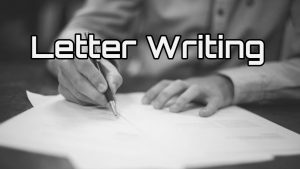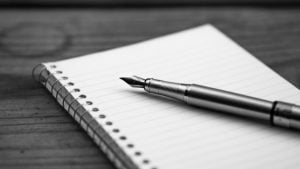Features Of A Formal Letter: Letter writing is a very important means through which individuals and groups communicate with each other. This involves the sending and receiving of written letters between the sender and the recipient. The letter sent and received typically contains the message which the sender wishes to convey to the recipient.

There are several types of a letter. A letter may be informal, semi-formal or formal. The use of a particular type of a letter depends entirely on the kind of person to whom the letter is addressed and the occasion or purpose for which the letter is being written.
Recommended: Why Lawyers Put On Wigs in Court
Meaning of a Formal Letter
A formal letter (business letter) is a type of letter written for official purposes and which follows prescribed conventions and format. A person who writes a formal letter must write the letter in line with the prescribed rules. The rules relate to the tone, language and structure of the letter.
There are several reasons why a person may write a formal letter. A person who wishes to lay a complaint to an official or government agency must adopt a formal letter. Also, a formal letter is required to apply for a job, sick or maternity leave, or to tender resignation. Furthermore, a letter for job offers, appointment and business partnership must be formal.
Also see: Best time to read and understand effectively
Top 8 Characteristics/Features of a Formal Letter
The features of formal letters refer to the manner of language used in writing formal letters. They also relate to the format or structure of the letter. The language and structure of the formal letter differentiate it from other types of letter writing. Where a formal letter is required or used, the rules in respect to language and structure must be observed.

1. The Language of a Formal Letter: A formal letter must be written in the appropriate way. The language used must be formal and professional. The language used must be courteous and decent. Again, the letter should be simple, precise and concise. Slangs, ambiguous and vague words are not used in writing formal letters.
In writing a formal letter, contractions should not be used. Contractions are words created by omitting or combining two or more words or sounds. Examples of contractions are ‘won’t‘ which is a contraction of ‘will not‘, ‘can’t‘ which is a contraction of ‘cannot‘ and ‘wouldn’t‘ which is a contraction of ‘would not ‘.
Also see: “My name is” and “My names are”: Which is Correct
2. Format Or Layout of a Formal Letter: The layout or format is a fundamental feature of formal letter. The letter must be properly structured. Hence, the different parts of the letter must be present and more importantly, should be assigned to their correct positions.
The different parts of a formal letter are the addresses and date, thee salutation, the subject, body of the letter, complimentary closing and the sign off.
The parts of the letter mentioned above are necessary and must be present in the letter. These are going to be explained in detail.

3. The Addresses and Date: There are two addresses which are found in a formal letter. These are the addresses of the sender and the recipient.
The first part of a formal letter is the sender’s address. The sender’s address is placed at the top-right corner of the page. This is the place where the sender can be found or communicated with. It could be the sender’s residence, street, business or mailing address.
The date is the next part of the letter. The date comes immediately below the sender’s address. The date, just like the sender’s address, is placed at the top-right corner of the letter. The month should be written as a word and not a number.
The next part of the letter is the receiver’s or addressee’s address. However, the name of the addressee or recipient of the letter comes before the address. The address comes immediately below the name of the recipient.
The address of the recipient is written on the left side of the letter below the sender’s address. The address could be the residence or business address of the recipient. However, where a person is being addressed in his official capacity, the address should be the address of his organisation or business. For example, where a job offer letter is to be communicated to the Head of Hunan Resources, the recipient’s address should be the address of the organisation in which he or she is working.
4. The Salutation: A formal letter starts with a salutation. The salutation is placed below the recipient’s address and before the subject of the letter.
The sender can salute the recipient by starting with ‘Dear’ followed by the title and name of the recipient. This could be the surname or first name of the recipient. For example : ‘Dear Ms Edith‘ or ‘Dear Mr. Edwards‘.
Where the sender does not know the name of the receiver, he or she should use ‘Dear Sir/Madam‘.
A comma should be added after the salutation.
Also see: Best apps for doctors and medical students
5. Subject of the Letters: This denotes the reason for the letter. It indicates the primary purpose for which the letter was written. For example, if the letter is written to obtain information about something, the subject of the letter can read :
5. Letter Of Enquiry: The sender should ensure that the subject clearly and concisely indicates the reason for the letter.
6. Body of The Letter: The body of the letter is arguably the most vital part of a formal letter. It captures the essence of the letter and the message which the sender wishes to convey to the receiver. For the purposes of convenience, brevity and clarity, the body of the letter is usually divided into paragraphs.
The first paragraph is basically used for introduction. In the first paragraph, the sender introduces himself or herself briefly. This is usually the case where the sender is not known to the receiver. For example, a job applicant can, in the first paragraph of the application of the letter, introduce himself or herself. The sender also uses the first paragraph to briefly state the purpose of the letter.
The subsequent paragraphs are used to give more relevant information and explain the reason for the letter. For example, the sender can use the subsequent paragraphs to give more information about the activity which necessitated his or her letter of complaint. The sender must convey his or her message in the subsequent paragraphs in a logical and concise manner.
The last paragraph is used to summarise the points raised in the preceding paragraphs and to make a request or to recommend a course of action. A job applicant can use the last paragraph to draw the attention of the receiver to the Curriculum Vitae or resumé attached to the letter.

Must read: Top online universities in the world 2021
7. The Complimentary/ Closing Paragraph: This is the part of a formal letter where the sender restates the points raised in the preceding paragraphs, expresses gratitude to the receiver for the anticipated consideration of the request or complaint, or expresses his or her availability for an interview. After that, the sender would close the letter.
8. Sign Off: The last part of the letter is the part where the sender closes the letter by stating his or her name and also appending his or her signature. The phrases ‘Yours faithfully,’ or ‘Yours sincerely,‘ are written above the name and signature of the sender. Where the name of the receiver was used in the salutation, the right phrase is ‘Yours sincerely,’. In cases where ‘Sir/Madam‘ was used, ‘Yours faithfully,’ is used.
The signature of the sender is placed immediately below the sign off phrases. The name of the sender is then placed immediately below the signature.
Also see: Major Barriers of effective Communication you should know
Conclusion: In spite of the advances in communication technology, formal letter writing still subsists as a useful and indispensable means of communicating with other persons or organisations. We can use formal letters to apply for a job, make a complaint to a government agency, request for information, seek for business partnership or apply for leave.
However, there are requirements which must be fulfilled in writing a formal letter. These relate to the language, tone and the layout or structure of the letter. The tone of a formal letter must be polite and the language professional, unambiguous and proper. Also, the proper structure must be set. The features of a formal letter discussed above are its distinguishing factors. They are valid requirements which a formal letter must fulfil.

Edeh Samuel Chukwuemeka, ACMC, is a lawyer and a certified mediator/conciliator in Nigeria. He is also a developer with knowledge in various programming languages. Samuel is determined to leverage his skills in technology, SEO, and legal practice to revolutionize the legal profession worldwide by creating web and mobile applications that simplify legal research. Sam is also passionate about educating and providing valuable information to people.
This write up is very interesting, keep it up.
U know well
I know say u know get Brain.😂🤣😅🧠💔🔇🇳🇬🇳🇫🇳🇬🇳🇫🇳🇬🇳🇫🇳🇬🇳🇫.